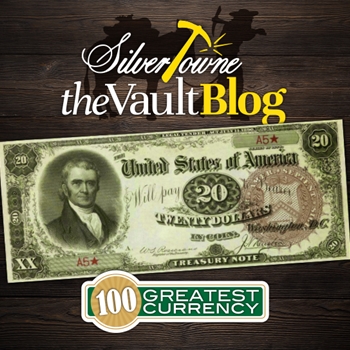
It says a lot about a person, especially at the time, to be an exception to a rule. While not a set in stone tradition, a departure from the norm back in the late 1890s was more than likely considered a big deal. This probably rings even more true in the world of coins and currency. How influential must one be for this to be the case?
Featured in the next entry of our breakdown of Whitman Publishing’s 100 Greatest American Currency Notes blog series, we will take a look at a circumstance that called for the above action. With help from authors Q. David Bowers and David M. Sundman, we will further look into a series note that was heavily influenced by the nation’s loss of one man.
#61 - With Ornate Back $20 Treasury or Coin Note, Series of 1890
The note itself is similar to other Series of 1890 Treasury or Coin Notes as it features the back side facing upward. “TWENTY” is featured in the center of the back with large ornate letters against a background that features intricate detail and open space. The front of the note, or the face as it is referred to, features the portrait of John Marshall, the fourth chief justice of the United States Supreme Court.This is unlike most of the notes from the series of 1890 and 1891 as it differs from the common use of Civil War figures. Over 1.2 million of this note was printed as Martin Gengerke documents 169 different types. Most of them show significant circulation.
Marshall, who died in 1835, was a significant figure in the United States. Even so much so that there is legend that his death and the cracking of the Liberty Bell during the tolling of his funeral was no coincidence. By the time this note was issued in 1890, the legend was believed to be true. The portrait of Marshall appearing on the face of the $20 note is believed to be based on the 1834 rendering of portraitist Henry Inman. Charles Schlect’s engraved portrait of the note is one of many contributed by the German-born artist.
Historic value of this note in a Very Fine condition in 1960 was $200. By 2006, the value went up to $6,700.







